steering Lancia Ypsilon 2002 Owner handbook (in English)
[x] Cancel search | Manufacturer: LANCIA, Model Year: 2002, Model line: Ypsilon, Model: Lancia Ypsilon 2002Pages: 191, PDF Size: 2.45 MB
Page 61 of 191

58
G
FRONT AND SIDE
AIRBAGS
FRONT AIRBAGS (fig. 85)
Description and operation
The front airbag (driver and pas-
senger) is a safety device which is im-
mediately triggered in the event of a
front impact.
It consists of an instantly inflatable
bag housed in a special compartment
located:
– in the centre of the steering wheel
on the driver’s side;
– in the dashboard on the passen-
ger’s side (larger bag).
The front airbag (driver and pas-
senger) is a device which protects the
occupants of the car during a head-on
collision of a medium-high degree.
The system was designed to protect
from injury caused by the body crash-
ing to the steering wheel or the dash-
board. IMPORTANTCars fitted with ABS
must always be fitted with the wheel
rims, tyres and brake linings of the
type and make recommended by the
Manufacturer.
The system also includes the EBD
electronic brake correction (Electronic
Brake Distributor) which, through the
control unit and the ABSsensors fur-
ther enhances the braking system.
The car is fitted with an
electronic brake distribu-
tor (EBD). If warning lights
>andxlight up simultaneously
when the engine is running, this
indicates an EBD fault. This
means that violent braking could
cause early locking of the rear
wheels causing the car to skid.
Drive very carefully to the nearest
LANCIA Dealership to have the
system checked.
If only warning light >
switches on when the en-
gine is running, this usu-
ally indicates an ABS fault. In such
cases the braking system is still ef-
ficient, although the anti-locking
device does not function. The EBD
system may also be less efficient.
Go to a LANCIA Dealership imme-
diately, taking care not to brake
suddenly, and have the system
checked.
If the xbrake fluid low
warning light comes on,
stop the car immediately
and contact the nearest LANCIA
Dealership. Fluid leaks from the
hydraulic system, can compromise
brake system operation, both tra-
ditional systems and systems with
ABS.
4C001-067 ING 11-03-2008 11:57 Pagina 58
Page 65 of 191
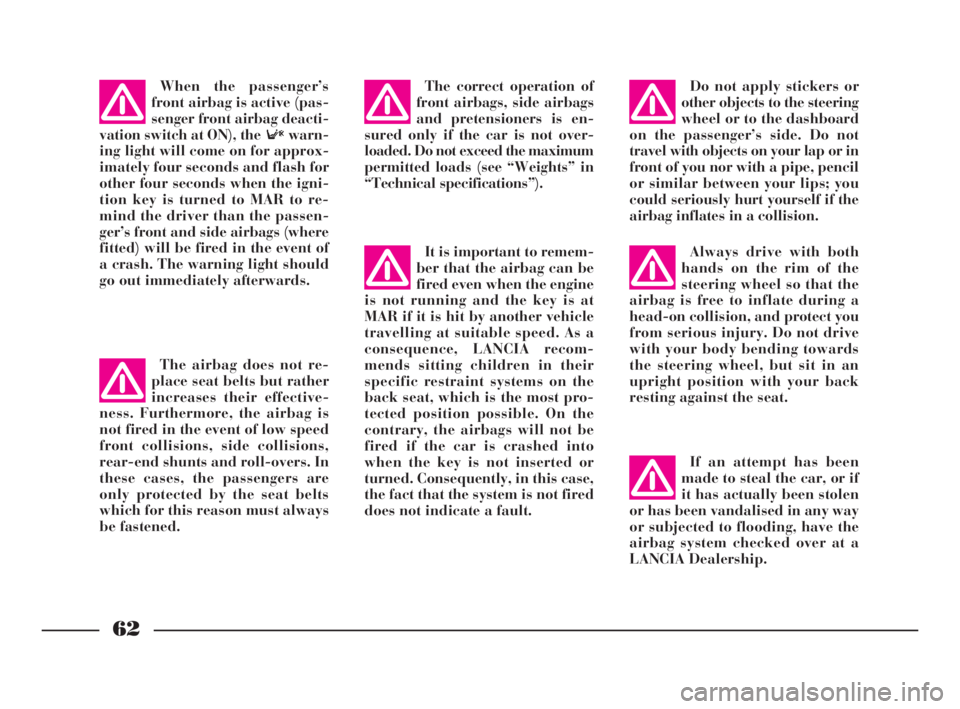
62
G
It is important to remem-
ber that the airbag can be
fired even when the engine
is not running and the key is at
MAR if it is hit by another vehicle
travelling at suitable speed. As a
consequence, LANCIA recom-
mends sitting children in their
specific restraint systems on the
back seat, which is the most pro-
tected position possible. On the
contrary, the airbags will not be
fired if the car is crashed into
when the key is not inserted or
turned. Consequently, in this case,
the fact that the system is not fired
does not indicate a fault.Always drive with both
hands on the rim of the
steering wheel so that the
airbag is free to inflate during a
head-on collision, and protect you
from serious injury. Do not drive
with your body bending towards
the steering wheel, but sit in an
upright position with your back
resting against the seat.
If an attempt has been
made to steal the car, or if
it has actually been stolen
or has been vandalised in any way
or subjected to flooding, have the
airbag system checked over at a
LANCIA Dealership. Do not apply stickers or
other objects to the steering
wheel or to the dashboard
on the passenger’s side. Do not
travel with objects on your lap or in
front of you nor with a pipe, pencil
or similar between your lips; you
could seriously hurt yourself if the
airbag inflates in a collision.
The correct operation of
front airbags, side airbags
and pretensioners is en-
sured only if the car is not over-
loaded. Do not exceed the maximum
permitted loads (see “Weights” in
“Technical specifications”).When the passenger’s
front airbag is active (pas-
senger front airbag deacti-
vation switch at ON), the warn-
ing light will come on for approx-
imately four seconds and flash for
other four seconds when the igni-
tion key is turned to MAR to re-
mind the driver than the passen-
ger’s front and side airbags (where
fitted) will be fired in the event of
a crash. The warning light should
go out immediately afterwards.
The airbag does not re-
place seat belts but rather
increases their effective-
ness. Furthermore, the airbag is
not fired in the event of low speed
front collisions, side collisions,
rear-end shunts and roll-overs. In
these cases, the passengers are
only protected by the seat belts
which for this reason must always
be fastened.
4C001-067 ING 11-03-2008 11:57 Pagina 62
Page 73 of 191

70
G
HOW TO WARM UP
THE ENGINE AFTER
IT HAS JUST STARTED
– Begin to move forward slowly let-
ting the engine turn over at medium
revs. Do not accelerate abruptly.
– Do not push the engine to its limit
for the first few kilometres. You are
recommended to wait until the water
temperature has reached 50°C to
60°C (pointer moves slightly from its
initial position).
EMERGENCY STARTING
If the Lancia CODE system fails to
recognise the code transmitted by the
ignition key (warning lamp ¢on in-
strument panel lit with a fixed light),
you can start the engine by following
the emergency procedure using the
code written on the CODE card.
See the section “In an emergency”.STOPPING THE ENGINE
Turn the ignition key to STOPwhile
the engine is idling.
Remember that as long as
the engine is not running,
the brake booster and
power steering do not work. You
therefore have to use considerably
more effort on both the brake
pedal and the steering wheel.
Bump starting by push-
ing, towing or rolling
downhill must be avoided
at all costs. This way of starting
could cause a rush of fuel into the
catalytic exhaust pipe and damage
it beyond repair.
BUMP STARTING
A quick burst on the ac-
celerator before turning off
the engine serves ab-
solutely no practical purpose, and
wastes fuel.
IMPORTANTAfter a taxing drive it
is better to allow the engine to “catch
its breath” before turning it off by let-
ting it idle to allow the temperature in
the engine compartment to fall.
4C068-089 ING 11-03-2008 11:59 Pagina 70
Page 78 of 191
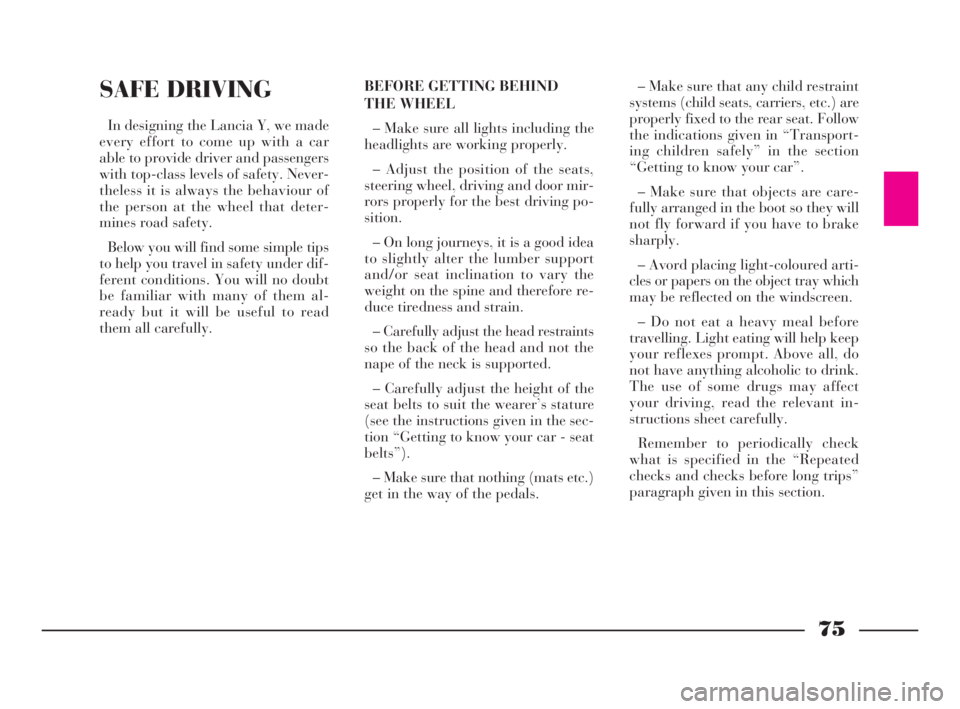
75
G
SAFE DRIVING
In designing the Lancia Y, we made
every effort to come up with a car
able to provide driver and passengers
with top-class levels of safety. Never-
theless it is always the behaviour of
the person at the wheel that deter-
mines road safety.
Below you will find some simple tips
to help you travel in safety under dif-
ferent conditions. You will no doubt
be familiar with many of them al-
ready but it will be useful to read
them all carefully.BEFORE GETTING BEHIND
THE WHEEL
– Make sure all lights including the
headlights are working properly.
– Adjust the position of the seats,
steering wheel, driving and door mir-
rors properly for the best driving po-
sition.
– On long journeys, it is a good idea
to slightly alter the lumber support
and/or seat inclination to vary the
weight on the spine and therefore re-
duce tiredness and strain.
– Carefully adjust the head restraints
so the back of the head and not the
nape of the neck is supported.
– Carefully adjust the height of the
seat belts to suit the wearer’s stature
(see the instructions given in the sec-
tion “Getting to know your car - seat
belts”).
– Make sure that nothing (mats etc.)
get in the way of the pedals.– Make sure that any child restraint
systems (child seats, carriers, etc.) are
properly fixed to the rear seat. Follow
the indications given in “Transport-
ing children safely” in the section
“Getting to know your car”.
– Make sure that objects are care-
fully arranged in the boot so they will
not fly forward if you have to brake
sharply.
– Avord placing light-coloured arti-
cles or papers on the object tray which
may be reflected on the windscreen.
– Do not eat a heavy meal before
travelling. Light eating will help keep
your reflexes prompt. Above all, do
not have anything alcoholic to drink.
The use of some drugs may affect
your driving, read the relevant in-
structions sheet carefully.
Remember to periodically check
what is specified in the “Repeated
checks and checks before long trips”
paragraph given in this section.
4C068-089 ING 11-03-2008 11:59 Pagina 75
Page 80 of 191
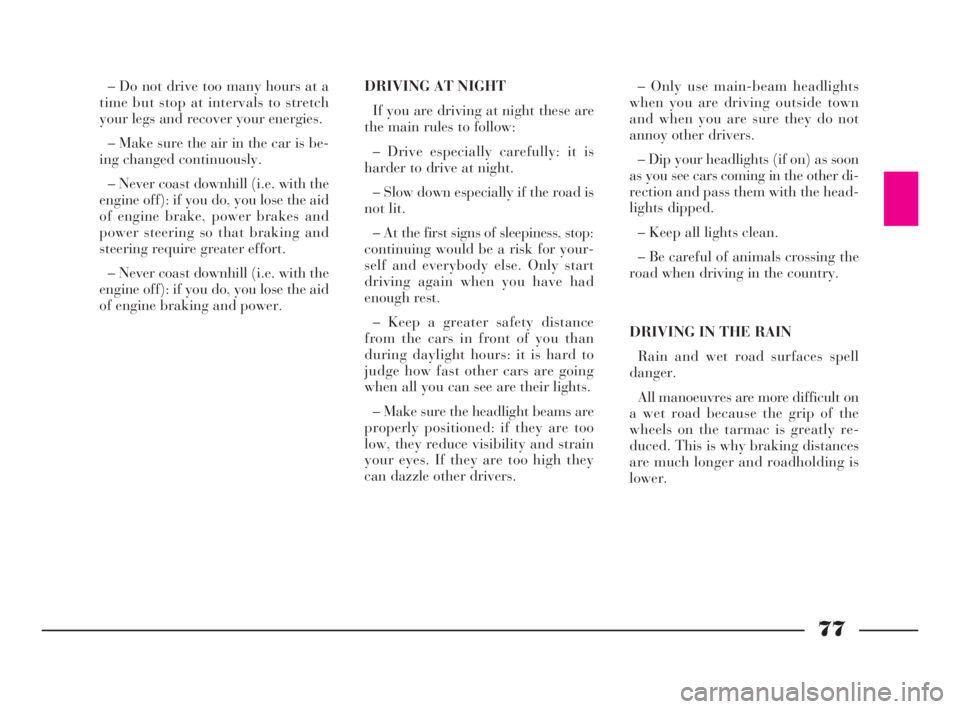
77
G
– Only use main-beam headlights
when you are driving outside town
and when you are sure they do not
annoy other drivers.
– Dip your headlights (if on) as soon
as you see cars coming in the other di-
rection and pass them with the head-
lights dipped.
– Keep all lights clean.
– Be careful of animals crossing the
road when driving in the country.
DRIVING IN THE RAIN
Rain and wet road surfaces spell
danger.
All manoeuvres are more difficult on
a wet road because the grip of the
wheels on the tarmac is greatly re-
duced. This is why braking distances
are much longer and roadholding is
lower. DRIVING AT NIGHT
If you are driving at night these are
the main rules to follow:
– Drive especially carefully: it is
harder to drive at night.
– Slow down especially if the road is
not lit.
– At the first signs of sleepiness, stop:
continuing would be a risk for your-
self and everybody else. Only start
driving again when you have had
enough rest.
– Keep a greater safety distance
from the cars in front of you than
during daylight hours: it is hard to
judge how fast other cars are going
when all you can see are their lights.
– Make sure the headlight beams are
properly positioned: if they are too
low, they reduce visibility and strain
your eyes. If they are too high they
can dazzle other drivers. – Do not drive too many hours at a
time but stop at intervals to stretch
your legs and recover your energies.
– Make sure the air in the car is be-
ing changed continuously.
– Never coast downhill (i.e. with the
engine off): if you do, you lose the aid
of engine brake, power brakes and
power steering so that braking and
steering require greater effort.
– Never coast downhill (i.e. with the
engine off): if you do, you lose the aid
of engine braking and power.
4C068-089 ING 11-03-2008 11:59 Pagina 77
Page 91 of 191
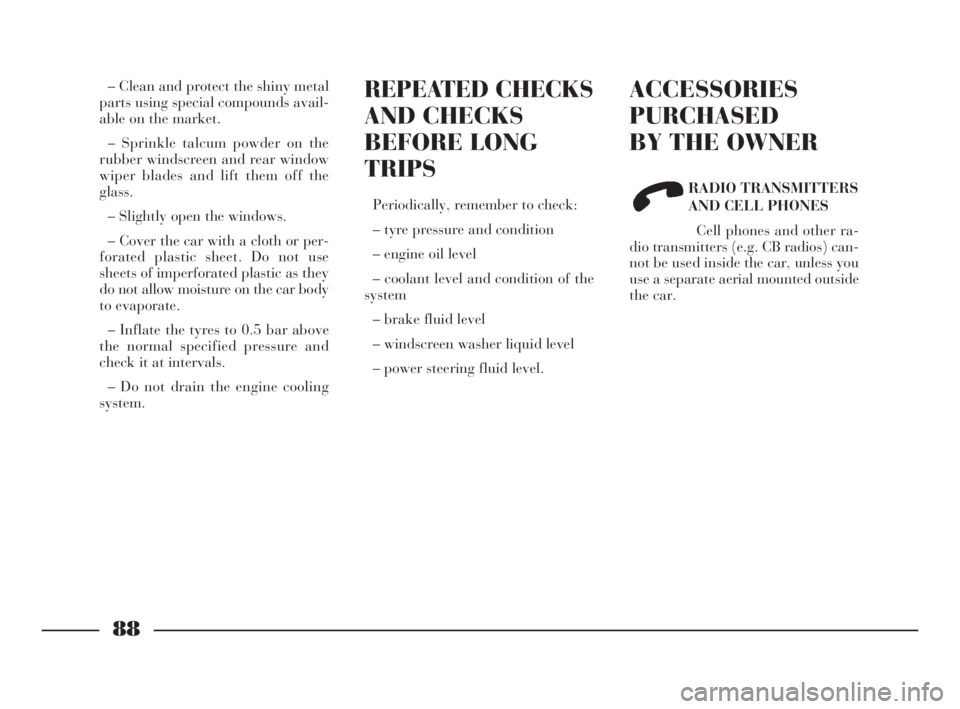
88
G
REPEATED CHECKS
AND CHECKS
BEFORE LONG
TRIPS
Periodically, remember to check:
– tyre pressure and condition
– engine oil level
– coolant level and condition of the
system
– brake fluid level
– windscreen washer liquid level
– power steering fluid level.
ACCESSORIES
PURCHASED
BY THE OWNER
RADIO TRANSMITTERS
AND CELL PHONES
Cell phones and other ra-
dio transmitters (e.g. CB radios) can-
not be used inside the car, unless you
use a separate aerial mounted outside
the car.
– Clean and protect the shiny metal
parts using special compounds avail-
able on the market.
– Sprinkle talcum powder on the
rubber windscreen and rear window
wiper blades and lift them off the
glass.
– Slightly open the windows.
– Cover the car with a cloth or per-
forated plastic sheet. Do not use
sheets of imperforated plastic as they
do not allow moisture on the car body
to evaporate.
– Inflate the tyres to 0.5 bar above
the normal specified pressure and
check it at intervals.
– Do not drain the engine cooling
system.
4C068-089 ING 11-03-2008 11:59 Pagina 88
Page 97 of 191

94
G
into the catalytic exhaust
pipe and damage it beyond
repair.
BUMP
STARTING
Bump starting by pushing, towing
or rolling downhill must be
avoided at all costs. This way of
starting could cause a rush of fuelRemember that as long as
the engine is not running,
the brake booster and
power steering do not work. You
therefore have to use considerably
more effort on both the brake
pedal and the steering wheel.
IF A TYRE
IS
PUNCTURED
GENERAL INDICATIONS
The following precautions must be
observed when changing a wheel and
using the jack and the space-saver
spare wheel.
4C090-119 ING 11-03-2008 12:00 Pagina 94
Page 111 of 191
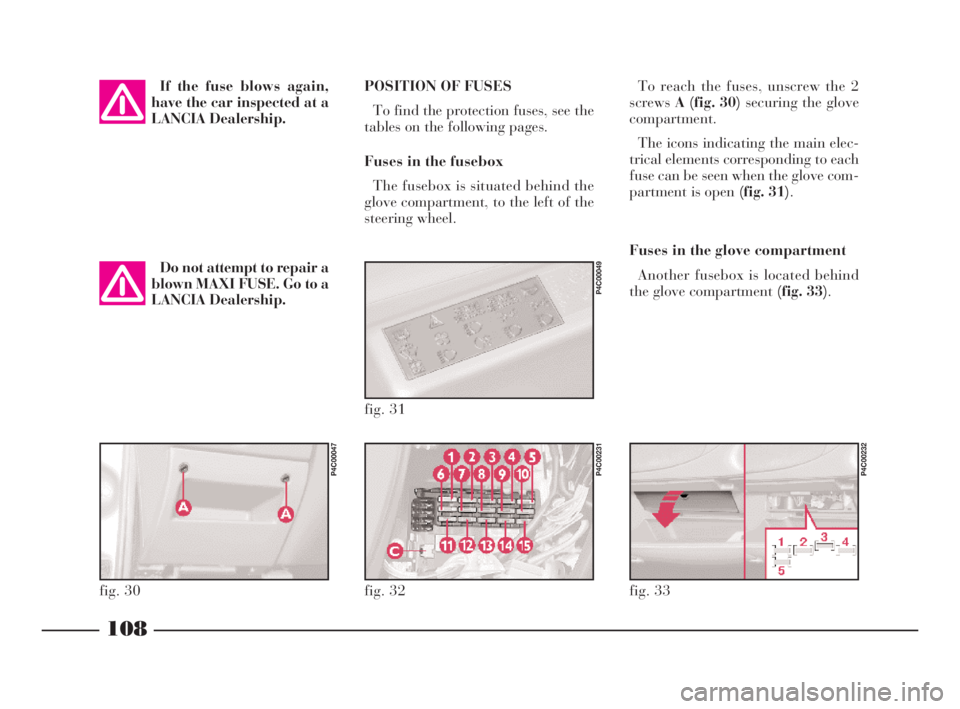
108
fG
POSITION OF FUSES
To find the protection fuses, see the
tables on the following pages.
Fuses in the fusebox
The fusebox is situated behind the
glove compartment, to the left of the
steering wheel.To reach the fuses, unscrew the 2
screwsA (fig. 30) securing the glove
compartment.
The icons indicating the main elec-
trical elements corresponding to each
fuse can be seen when the glove com-
partment is open (fig. 31).
Fuses in the glove compartment
Another fusebox is located behind
the glove compartment (fig. 33).
fig. 32
P4C00231
fig. 33
P4C00232
fig. 31
P4C00049
fig. 30
P4C00047
If the fuse blows again,
have the car inspected at a
LANCIA Dealership.
Do not attempt to repair a
blown MAXI FUSE. Go to a
LANCIA Dealership.
4C090-119 ING 13-03-2008 12:51 Pagina 108
Page 120 of 191

117
fG
While the car is being
towed with the engine off,
remember that the brake
pedal and steering will require
more effort as you no longer have
the benefit of the brake booster
and power steering. Do not use
flexible cables to tow. Avoid jerk-
ing. Whilst towing, ensure that the
coupling to the car does not dam-
age the surrounding components.Do not extract the igni-
tion key during towing;
leave it at MAR, to prevent
the steering lock engaging and,
provided the electrical system is
not damaged, keep the brake lights
and direction indicators working.
When the ignition key is re-
moved, the steering lock will cut in
thus preventing the steering wheel
from being turned.IF AN ACCIDENT
OCCURS
– It is important to keep calm.
– If you are not directly involved,
stop at least ten metres away from the
accident.
– If you are on a motorway do not
obstruct the emergency lane with your
car.
– Turn off the engine and turn on
the hazard lights.
– At night, illuminate the scene of
the accident with your headlights.
– Act carefully, you must not risk
being run over.
– Mark the accident by putting the
red triangle at the regulatory distance
from the car where it can be clearly
seen.
– If the doors are jammed, do not try
to leave the car by breaking the glass
of the windscreen as the glass is strat-
ified. Side windows and the rear win-
dow can be broken more easily.
4C090-119 ING 13-03-2008 12:51 Pagina 117
Page 127 of 191
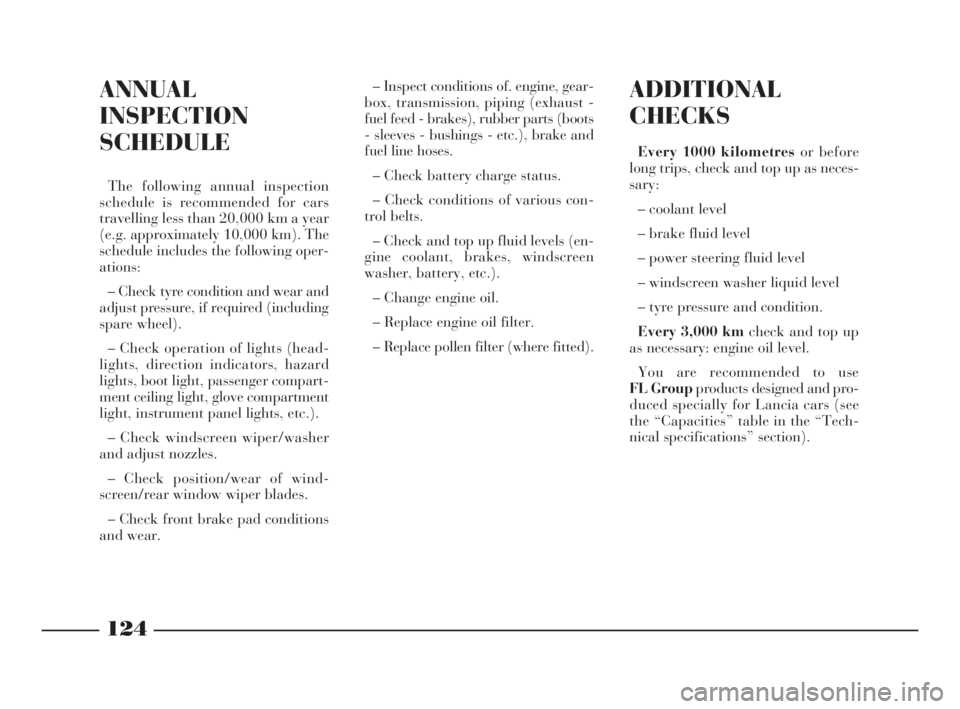
124
G
ADDITIONAL
CHECKS
Every 1000 kilometres or before
long trips, check and top up as neces-
sary:
– coolant level
– brake fluid level
– power steering fluid level
– windscreen washer liquid level
– tyre pressure and condition.
Every 3,000 kmcheck and top up
as necessary: engine oil level.
You are recommended to use
FL Groupproducts designed and pro-
duced specially for Lancia cars (see
the “Capacities” table in the “Tech-
nical specifications” section).
ANNUAL
INSPECTION
SCHEDULE
The following annual inspection
schedule is recommended for cars
travelling less than 20,000 km a year
(e.g. approximately 10,000 km). The
schedule includes the following oper-
ations:
– Check tyre condition and wear and
adjust pressure, if required (including
spare wheel).
– Check operation of lights (head-
lights, direction indicators, hazard
lights, boot light, passenger compart-
ment ceiling light, glove compartment
light, instrument panel lights, etc.).
– Check windscreen wiper/washer
and adjust nozzles.
– Check position/wear of wind-
screen/rear window wiper blades.
– Check front brake pad conditions
and wear.– Inspect conditions of. engine, gear-
box, transmission, piping (exhaust -
fuel feed - brakes), rubber parts (boots
- sleeves - bushings - etc.), brake and
fuel line hoses.
– Check battery charge status.
– Check conditions of various con-
trol belts.
– Check and top up fluid levels (en-
gine coolant, brakes, windscreen
washer, battery, etc.).
– Change engine oil.
– Replace engine oil filter.
– Replace pollen filter (where fitted).
4C120-143 ING 11-03-2008 12:01 Pagina 124